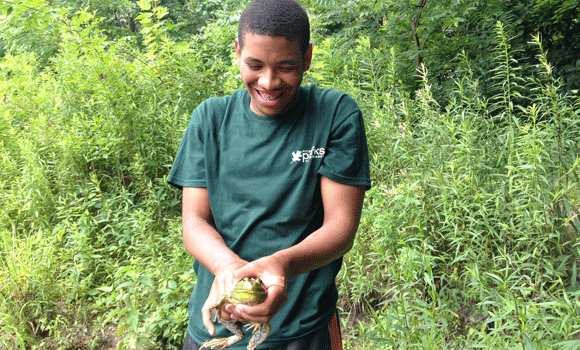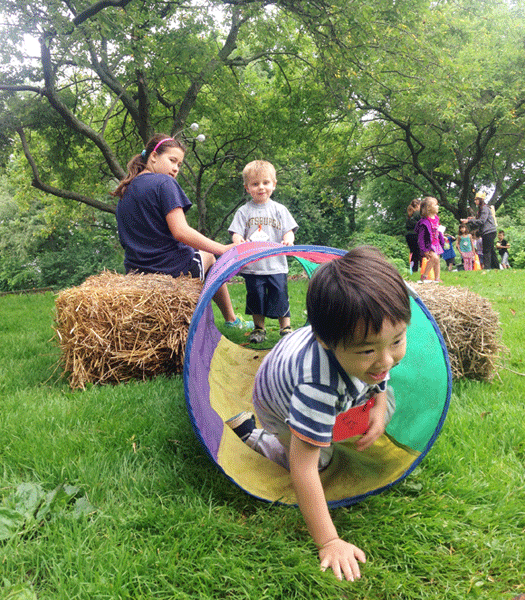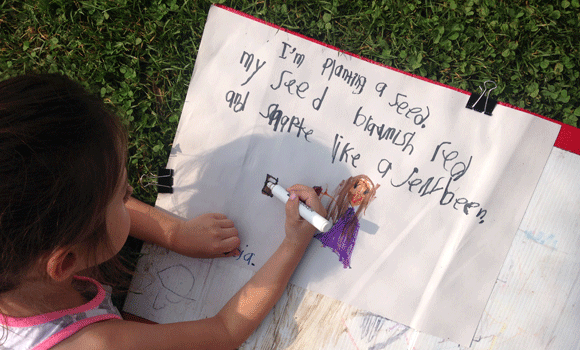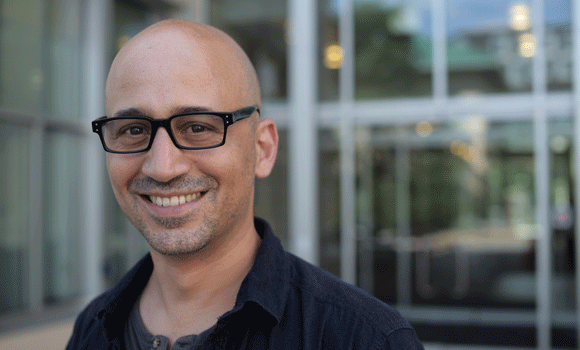Pittsburgh’s historic parks system is comprised of 1,768 acres of pristine, natural loveliness, boasting tree-lined trails, tranquil lakes, and all manner of wildlife that buzzes, flaps and swims. The region’s nonprofit parks conservation group sees not just beauty here, but a vast outdoor classroom and learning laboratory for Pittsburgh Public Schools.
With a huge swath of greenery at its disposal, the Pittsburgh Parks Conservancy is partnering with the school system to provide a nationally recognized STEM-based (science, technology, engineering and mathematics) learning experience to students from pre-school through high school.
“We love the parks,” enthuses Marijke Hecht, the Conservancy’s director of education. “We want to use them to give students hands-on opportunities to explore environments that incorporate many STEM skills.”
Science is everywhere, encompassing lands and oceans, galaxies and stars, as well as the technologies we interact with daily. Letting students explore and learn scientific ideas via hands-on experience can catalyze an explosion of energy — especially when most of their time is spent in the urban landscape of buildings and sidewalks.
“These kids don’t see themselves wearing a lab coat indoors,” says Hecht. “Learning about science outside is what excites them.”
A panoply of programming
While the Conservancy has provided school-age scientists with educational programming since its inception in 1996, that activity has ramped up over the last six years. After launching with two schools and five classes, demand for STEM-related activity has allowed the organization to expand its reach to 20 schools and 43 classes.
The Pittsburgh Parks Conservancy expects to interact with about 1,000 students between September and May, with each class treated to between two and five programs over the course of the year. The group designs programming with partner schools including the Pittsburgh Science & Technology Academy, tailoring age-appropriate curriculum for students interested in the STEM-centric attributes of innovation, discovery and development.
With the organization since 2009, Hecht has fostered the education programs as they’ve developed, mapping them with state academic standards across a range of STEM-related disciplines, skills and practices.
These experiences could encourage parents to take part in their child’s learning as well. Learning and experiencing the immense possibilities that the natural world has to offer together, could kickstart your child’s interest in science, help hone their scientific thinking skills, and prepare them for a challenging yet interesting path ahead.
“These aren’t field trips or one-off experiences,” she explains. “We’re building a knowledge base while getting these students comfortable with the parks system.”
As a whole, the Conservancy’s education venture is meant to introduce children to the wonders of nature at a young age, ingraining an appreciation for the outdoors that evolves into a feeling of stewardship. The outdoorsy enterprise is broken down into five areas, all of them centered around Frick and Schenley Parks, with day trips being planned for Highland and Riverview Parks.
In Nature School (ages 3-5), children explore Frick Park, interacting with the outdoors through the use of their senses. Lessons include songs and stories that teach respect and appreciation for the environment.
At Habitat Explorers (first grade), guided exploration activities take students through Frick, where they observe how organisms live in various habitats throughout the year. Participants engage in stewardship projects such as seeding and eco art.
In fourth grade, students become Park Stewards; discovery, scientific illustration and sensory journaling are all components of the program, which analyzes components of a site in Frick to observe how it changes over time.
In Mission Ground Truth (seventh-eighth grade), students evaluate the health of forest and stream ecosystems, employing the tools and sampling methods used by scientists in the field to collect data and gain an understanding of the connection between the health of ecosystems and the services they provide.
Lastly, as High School Urban EcoStewards, classes adopt a quarter acre of park land, tending it year-round and recording their experiences in field journals. Students work in teams to perform ecological restoration projects, identify native and non-native plant life, and learn about the value of parks and green space.
Kevin Tyler, a junior at Westinghouse High School, is in the stewards program, taking part in projects such as making a walkway out of wooden boards for a hiking trail. The program was perfect for Tyler, a self-proclaimed “nature nut” with an eye toward a computer engineering major at University of Pittsburgh.
“I love the environment to begin with,” he says. “I just like to go to parks or a national forest and hang out. It’s my favorite pastime.”
The environmentally friendly learning program dovetails nicely with his involvement in the Student Conservation Association, a national nature stewardship group that takes participants on camping trips and helps with the restoration of parks, waterfronts and urban landscapes.
Tyler’s career ambition may not be to save the trees, but thanks in part to the Conservancy, he can envision himself including an environmental piece into any future computer science profession.
“I could create an application for your smartphone that would let you point your camera at a plant or animal, and it would tell you how old it is based on past research,” he muses.
Better to be there
Paul Ronevich teaches environmental science at Pittsburgh Science & Technology Academy, which carries a diverse, multi-racial enrollment of 538 students in grades six through 12. Ronevich’s pupils learn about the political underpinnings of pollution, human health and energy through the lens of biology, ecology and chemistry.
The Academy in its third year of partnership with the Conservancy; students spend five days a year as ecostewards. The class spent late fall and early winter studying or hiking through Schenley Park to learn how ecological systems change and adapt in cold weather. At a recent session, participants learned about the overgrowth of Japanese knotweed and how this non-native plant species can be harmful to the park’s biodevelopment.
“These are kids from urban settings who don’t have much exposure to nature, so they go out and explore,” says Ronevich. “They’re going out making observations, asking questions, or just finding something that interests them.”
The educator’s students are also helping to maintain parkland upstream of Panther Hollow Lake in Schenley Park, journaling their work and bringing that information back to the Academy. The transition from parkland to classroom is natural, with Ronevich helping to plan an upcoming session on green water infiltration that will take place around the school’s Oakland campus.
When it comes to learning about nature, it’s better to be there, argues Ronevich. His students glean much more from actually seeing a tree damaged by infestation of the emerald ash borer than by simply reading about the destructive insect in a book.
“To see these big trees killed by these bugs is a lot more impactful for them,” he insists.
In addition to the programming with the Pittsburgh Parks Conservancy, Pittsburgh public schools are making other efforts to connect STEM education with the city’s urban environs. Students from Pittsburgh Gifted Center recently explored the microorganisms living in their tap water at home as part of the Pittsburgh Water Microbiome Project.
After collecting the water samples, students returned them to University of Pittsburgh Assistant Professor Kyle Bibby, who started the project to find out which microorganisms reside in the city’s drinking water. Bibby’s undergraduate students in Pitt’s Swanson School of Engineering processed the samples, which are now part of a new permanent exhibit called H2Oh! at the Carnegie Science Center.
The city also has an environmental charter school in Frick Park for students in kindergarten through eighth grade; its popularity is evident in its extensive waitlist.
Real-world connection
Working with teachers has helped the Pittsburgh Parks Conservancy refine its programming. The organization has additional partnerships with higher-education entities such as Carnegie Mellon University‘s Community Robotics, Education and Technology Empowerment Lab (CREATE).
Part of CREATE’s year-long advocacy video project for teens — dubbed Hear Me — concentrates on student perspectives of local parkland, which the Conservancy uses to assess prospective learning opportunities.
The lab also partners directly with the parks organization on Mission Ground Truth, lending its GigaPan camera-mount technology to the program so students could take panoramic photographs of their surroundings.
Dror Yaron, director of outreach at CREATE, appreciates the parks system’s intimate approach to environmental science education.
“STEM has to connect students to the real world and the things they care about,” says Yaron. “It should allow them the chance to make a difference in their communities.”
The Conservancy garnered national recognition in February when Hecht was named recipient of the 2015 Carnegie Science Center Award for her efforts harnessing Pittsburgh’s public parks as a learning tool.
“I would love for everyone to become an environmental scientist, but this kind of education can translate to any field,” explains Hecht. “It’s about making observations and then trying to answer those questions for yourself.”





